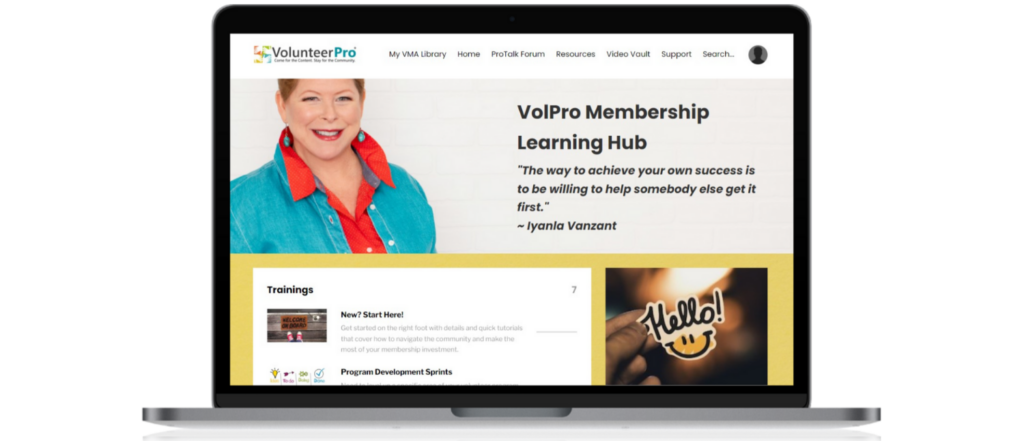9 Hot Tips to Build a Stellar Feedback Survey for Volunteers
Right now is an excellent time to release a survey for volunteers, and gain insights about how you can better support your team and remove any roadblocks they are facing to full involvement.
You can use a feedback questionnaire to determine who’s ready to return to work, or why they might be hesitant about re-starting. For those that are volunteering now, or volunteered through the pandemic, you can assess their current level of fatigue and inspiration.
And, if you are considering changes to your program, volunteer support, or requirements in the year ahead, you can gather volunteer suggestions and concerns about what lies ahead.
Surveys aren’t just for volunteers either. You can survey co-workers who work with volunteers to find out how they would be like to be supported, what challenges they are facing, or how amenable they might be to possible volunteer placements.
The fact is, without data, it will be difficult to track trends and make meaningful adjustments to your volunteer management practices, both those that support volunteers and those that support employees.
Certainly, there is scholarly research on key drivers of volunteer satisfaction and retention. And a review of these studies can be helpful.
But there’s nothing quite like conducting your own research to find out how things are going in your own shop.
9 Tips to Guide Development of an Exceptional Survey for Volunteers
Gathering candid opinions from your volunteers will help you gain valuable insights into what you need to improve.
And, while it’s tempting to think that simply putting together a list of questions will generate the kind of quality intel you need, it takes a little more effort than that.
Below are some of my top suggestions that will help generate the rich, actionable feedback you need:
- TIP #1 Keep it Simple — The longer the survey questionnaire, the less likely your respondents are to finish it. Show respect for your volunteers’ time and keep your survey short. Even though it is tempting to add a lengthy list of questions, keep it to less than ten.
- TIP #2 Keep it Easy — In order to make it manageable for both you and your volunteers, use free or low-cost online survey software (e.g., SurveyMonkey). Send out invitations via email to easily capture and automatically report your responses. Make paper surveys available to those who don’t have Internet access.
- TIP #3 Keep it Real — Just like other communications, stay away from jargon or acronyms that will confuse respondents, regardless of how long volunteers have been onboard.
- TIP #4 Keep it Friendly — Always “bookend” your survey with a concise introduction at the beginning and an authentic thank you at the end. Satisfaction surveys are another way to build relationships with your volunteers. Let them know why they’ve been invited, what you hope to gain and when they will hear back from you with your next steps. Finally, give them a specific contact person in case they have questions or experience problems.
- TIP #5 Keep it Organized — Focus on using structured questions rather than relying primarily on open-ended questions. When designing your questionnaire, ask a few volunteers to help you brainstorm all the possible answers to a question. Then, categorize your answers into neat, multiple-choice options. Add the category of “other” and allow respondents to add their own responses but try to make your list as exhaustive as possible. This makes it much easier to analyze results.
- TIP #6 Keep it Focused — Always ask volunteers to rate how likely it would be for them to recommend their volunteer experience to friends and family. This question gets at perceived value, which is the core of what drives volunteer satisfaction. If you track this metric over time, you’ll see whether your value goes up or down in the volunteers’ eyes. Also, ask why they chose this rating in a subsequent open-ended question so you can find the root cause of their delight or displeasure.
- TIP #7 Keep it Open — Always invite volunteers to share added comments in an open-ended question at the end. That sends a clear message to volunteers that your ears are open, and you are willing to hear candid comments even if they don’t fit into neat boxes.
- TIP #8 Keep it Functional — Have a few volunteers test your online (and paper) survey instruments. Make sure they understand what your questions are really asking. Also, confirm with your testers that your list of multiple-choice options includes a broad enough selection.
- TIP #9 Keep it Accurate — You want to be able to defend your survey results and have confidence in your analysis. As such, make sure you have collected enough responses to generalize your results (collect a “statistically relevant” sample size) — the smaller the population, the larger percentage of responses you must collect. Try to attain a completion level of 95% with a +/- 5% margin of error. Also, when using ranges, give respondents at least five data points to choose from (called a “Likert-type scale).”
For our ultimate guide to writing effective feedback tools, check out How to Write Volunteer Surveys for Big Impact HERE >>
In addition, be prepared for the “halo effect.” Volunteers and service beneficiaries alike are reluctant to give negative feedback to nonprofit staff. If they are bothered by something, volunteers will often leave the organization before they will tell staff about their frustrations.
To encourage wide and honest participation from volunteers, collect responses anonymously and let volunteers know their privacy will be protected. When reporting the results, choose representative statements from the open-ended comments and do not associate them with an individual’s name. Pay attention to complaints; they are likely the beginning.
When you have a survey that works, stick with it through several survey seasons. Consider your survey successful when it gets you the information you need to take action, not necessarily because it generates a glowing report.
Once you have a design that is feeding you valuable insights, resist the temptation to tweak your core questions each time. That way, you can build a baseline of trustworthy trending data from which to work.
Finally, recognize that no satisfaction survey will get you all the information you need. If your survey results raise added questions, think about facilitating a volunteer focus group to get at some of the deeper drivers of satisfaction/dissatisfaction.
If you are worried that volunteers won’t be completely candid with you or your staff, hire an outside facilitator to manage the focus group for you.
You can also use social media to facilitate conversations within your volunteer team about their needs or you can review your volunteer retention metrics, analyze where and when people are leaving and ask why.
For more on how to use the data you collect to make a compelling case for support, check out How to Use Volunteer Surveys to Support Winning Grant Proposals HERE >>
An Alternate Survey for Volunteers: Exit Interviews
Technically the term “survey” can apply to any method for collecting perception information from an audience.
As such, questionnaires are not the only way to evaluate volunteer satisfaction. A survey of volunteers might also include exit interviews. Interviews, unlike surveys, allow for the possibility for follow-up questions for greater clarity.
These interviews with volunteers can be a terrific way to gather their final suggestions on their way out the door. Below are eight areas you might choose to cover in the exit interview:
These interviews with volunteers can be a terrific way to gather their final suggestions on their way out the door. Below are eight areas you might choose to cover in the exit interview:
- Length of tenure and role(s) of volunteer
- What they enjoyed about volunteering
- Why they decided to resign
- Whether they felt adequately trained
- Whether they felt the role was a good fit
- Whether they believe they were presented with an honest depiction of the volunteer opportunities when recruited
- What responsibilities they were not allowed or offered that they would have enjoyed
- What they would suggest to improve the volunteer program
Volunteer participation in exit interviews should be voluntary and departing volunteers should not be compelled to participate but it should be highly encouraged. When conducting exit interviews, make sure volunteers are as comfortable as possible in providing candid feedback; therefore, their former supervisor should not conduct the interview.
Exit interviews should remain confidential, and only general information should be shared. Those who conduct exit interviews must conduct themselves in a highly professional manner, maintaining privacy and refraining from gossip.
The best way is to aggregate the data collected over a specific period (e.g., quarterly) and report representative comments. Information gathered could also be reviewed for ideas about how to recognize and motivate volunteers.
If discrimination, harassment, or abuse was what caused the volunteer to resign, then this information should be reported to the program coordinator or executive management immediately.
Volunteer exit interviews can be conducted in person or over the phone.
Learn Program Assessment – Go Deeper with Expert Training & Advice
If you’re ready to develop your next survey of volunteers, learn more about how to assess your volunteer program on a deeper level, get connected, and get fired up to do the hard work and take on the world, we’re right there with you.
In fact, there is a whole community of like-minded people who are leaning into learning more about how to improve their operations and make a bigger impact in our VolunteerPro Membership.
VolunteerPro Membership is for any mission-driven nonprofit professional wanting to level up their volunteer engagement and gain traction on their organization’s most important goals.
Within membership, you’ll find in-depth training on all the volunteer topics you’ve been researching, including how to build and deploy an effective volunteer feedback survey. Membership includes access to a huge digital library of what-works-now content, live monthly seminars, workshops, and coaching calls, as well as a vibrant community of volunteer leaders to share ideas and questions with.
You’ll take what you learned in this blog and go much deeper into a variety of ways you can gather volunteer feedback and assess your operations. You’ll get both training and time-saving tools and templates to gather the right feedback at the right time.
Enrollment for new members is open NOW, with discounts available for monthly and annual memberships. But don’t delay because prices go back up after June 8th!
You can find out more about membership HERE.









